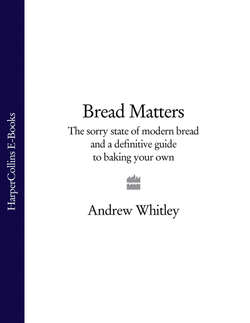Читать книгу Bread Matters: The sorry state of modern bread and a definitive guide to baking your own - Andrew Whitley - Страница 66
Extraction rate
ОглавлениеExtraction rate is the term used in the UK to denote the amount of the original grain left in the flour. Milling between stones gives a flour with all the constituents of the original grain mixed together: the mill has ‘extracted’ 100 per cent of the grain. This is known as a high extraction rate flour. To make white flour, the mill strips and sifts out the germ and the bran layers on the outside of the wheat grain which together constitute about 28 per cent of the grain, leaving a 72 per cent’ extraction flour. There are various grades in between: brown flour has some of the bran and germ replaced to take it back to about 80 per cent of the original grain.
The problem for the home baker is that, apart from ‘100 per cent whole- meal’, extraction rate is rarely mentioned on flour bags in so many words. Indeed, words like ‘brown’ and ‘mixed grain’ actually confuse the issue, perhaps sounding a bit nearer to ‘whole’ than they really are.
Here are some typical UK flours with their approximate extraction rates and other details:
Self-raising flours are usually lower-protein flours (white, wholemeal or brown) with added baking powder. They are designed for making cakes and scones.
Incidentally, ‘wholewheat’ is the term Americans use for wholemeal. It is specific to wheat, of course; the British wholemeal can be applied to any grain, hence wholemeal rye flour, wholemeal buckwheat flour. Latterly the term ‘wholegrain’ has emerged as an alternative. Thus ‘wholegrain wheat flour’ is the same as what the British call ‘wholemeal wheat flour’. If you find this confusing, wait until you see industrial millers and bakers touting products made with ‘white wholegrain flour’. It is already happening, in defiance of language if not of nutritional good sense. The flour thus named claims to be milled from a variety of ‘white’ (light-coloured) American wheat using a process that grinds the bran so finely that it becomes invisible. Expect a revelation in due course that rather less than 100 per cent of the wheat grain ends up in this ‘wholegrain’ flour.
The flour classification system used on the Continent is based on ‘ash content’, a measurement of the minerals left when all the other constituents of flour are burned. The lower the number, the lower the mineral content, reflecting the degree of refinement of the flour, and therefore of its loss of nutritional value (the lower the ash content, the less nutritious the flour).
The problem with the Continental system is that, while it tells you a good deal about the presence or absence of the branny parts of the grain, which contain all the minerals, it says nothing about the protein content of the flour. Which is a pity, because for bread baking, much depends on the quantity and quality of flour protein.
